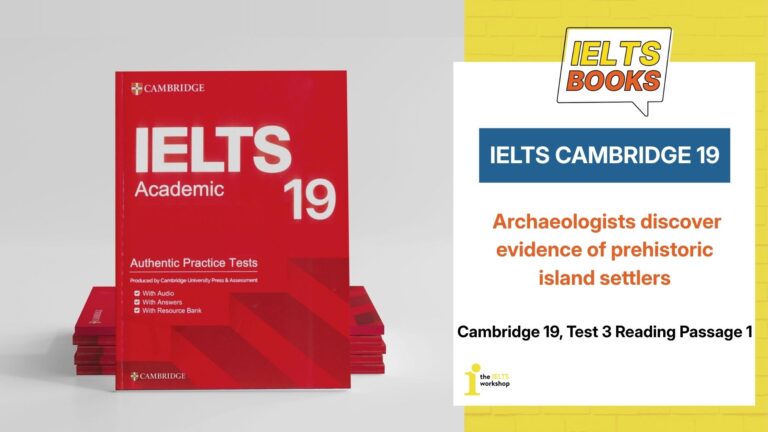Bài viết cung cấp đáp án và lời giải chi tiết IELTS Cambridge 19 Test 3 Reading Passage 1: Archaeologists discover evidence of prehistoric island settlers. Hy vọng rằng, bạn có thể kiểm tra bài làm của mình và nâng cao kĩ năng làm bài reading bạn nhé.
Đáp án IELTS Cambridge 19 Test 3 Reading Passage 1
| Câu hỏi | Đáp án |
| 1 | FALSE |
| 2 | FALSE |
| 3 | TRUE |
| 4 | Not given |
| 5 | TRUE |
| 6 | Not given |
| 7 | FALSE |
| 8 | caves |
| 9 | stone |
| 10 | bones |
| 11 | beads |
| 12 | pottery |
| 13 | spices |
Phân tích chi tiết IELTS Cambridge 19 Test 3 Reading Passage 1
Question 1. False
Câu hỏi: Archaeological research had taken place on the island of Obi before the arrival of Ceri Shipton and his colleagues. (Nghiên cứu khảo cổ học đã diễn ra trên đảo Obi trước khi Ceri Shipton và các đồng nghiệp đến.)
Vị trí: Đoạn A.
Transcript: Dr Ceri Shipton and his colleagues from Australian National University became the first archaeologists to explore Obi.
Phân tích: Bài đọc cho biết họ là những nhà khảo cổ đầu tiên khám phá đảo Obi, do đó không có cuộc nghiên cứu khảo cổ nào trước đó diễn ra trên đảo này. Câu hỏi trái ngược với thông tin nên đáp án là False.
Question 2. False
Câu hỏi: At the Kelo sites, the researchers found the first clam shell axes ever to be discovered in the region. (Tại Kelo, các nhà nghiên cứu tìm thấy những chiếc rìu vỏ sò đầu tiên được phát hiện trong khu vực.)
Vị trí: Đoạn C.
Transcript: Axes made from clam shells from roughly the same time had also previously been found elsewhere in this region, including on the nearby island of Gebe.
Phân tích: Các rìu làm từ vỏ sò đã từng được phát hiện ở các nơi khác trong khu vực trước đó, không phải lần đầu tiên. Vì vậy đáp án là False.
Question 3. True
Câu hỏi: The size of Obi today is less than it was 18,000 years ago. (Kích thước của Obi ngày nay nhỏ hơn so với 18.000 năm trước.)
Vị trí: Đoạn D.
Transcript: Sea levels were about 120 metres lower, meaning Obi was a much larger island.
Phân tích: Mực nước biển ngày xưa thấp hơn nên Obi từng là đảo lớn hơn. Nay mực nước biển cao hơn thì diện tích đảo nhỏ lại. Đáp án là True.
Question 4. Not given
Câu hỏi: A change in the climate around 11,700 years ago had a greater impact on Obi than on the surrounding islands. (Sự thay đổi khí hậu khoảng 11.700 năm trước có ảnh hưởng lớn hơn đến Obi so với các đảo xung quanh.)
Vị trí: Đoạn E.
Transcript: The climate became significantly warmer and wetter … making Obi’s jungle much thicker.
Phân tích: Chỉ có thông tin về tác động khí hậu đến Obi mà không so sánh với các đảo khác. Do đó, đáp án là Not given.
Question 5. True
Câu hỏi: The researchers believe there is a connection between warmer, wetter weather and a change in the material used to make axes. (Các nhà nghiên cứu tin rằng có liên hệ giữa khí hậu ấm, ẩm hơn và sự thay đổi vật liệu làm rìu.)
Vị trí: Đoạn E.
Transcript: According to the researchers, it is no coincidence that around this time the first axes crafted from stone rather than sea shells appear.
Phân tích: Khi khí hậu thay đổi khiến rừng dày hơn, rìu đá thay thế rìu vỏ sò để phù hợp hơn với điều kiện môi trường. Đáp án là True.
Question 6. Not given
Câu hỏi: Shipton’s team were surprised to find evidence of the Obi islanders’ hunting practices. (Nhóm của Shipton ngạc nhiên khi phát hiện bằng chứng về hoạt động săn bắn của người dân Obi.)
Vị trí: Đoạn F.
Transcript: Judging by the bones which the researchers unearthed … people mainly hunted the Rothschild’s cuscus.
Phân tích: Bài đọc nói họ tìm thấy xương, từ đó biết người dân săn cuscus. Không có thông tin nào nói họ bất ngờ hay ngạc nhiên. Đáp án là Not given.
Question 7. False
Câu hỏi: It is thought that the Kelo shelters were occupied continuously until about 1,000 years ago. (Người ta cho rằng nơi trú ẩn ở Kelo có người sinh sống liên tục cho đến khoảng 1.000 năm trước.)
Vị trí: Đoạn I.
Transcript: There is no evidence for use of the Kelo shelters after this time, until about 1,000 years ago, when they were re-occupied.
Phân tích: Không có bằng chứng cho thấy nơi trú ẩn được sử dụng trong khoảng từ 8.000 đến 1.000 năm trước, tức không có sự cư trú liên tục. Đáp án là False.
Question 8. caves
Câu hỏi: Excavations of rock shelters inside _____ near the village of Kelo revealed: (Cuộc khai quật nơi trú ẩn bằng đá bên trong _____ gần làng Kelo đã tiết lộ:)
Vị trí: Đoạn C.
Transcript: Shipton and his colleagues found two caves containing prehistoric rock shelters.
Phân tích: Hai nơi trú ẩn bằng đá nằm bên trong hang động. Đáp án là caves.
Question 9. stone
Câu hỏi: Axes made out of _____ dating from around 11,700 years ago (Rìu làm bằng _____ có niên đại khoảng 11.700 năm trước)
Vị trí: Đoạn E.
Transcript: The first axes crafted from stone rather than sea shells appear.
Phân tích: Phân tích: Sau thay đổi khí hậu, rìu được làm từ đá thay vì vỏ sò. Đáp án là stone.
Question 10. bones
Câu hỏi: _____ of an animal: evidence of what ancient islanders ate (_____ của một con vật: bằng chứng cho thấy người dân đảo cổ đã ăn gì)
Vị trí: Đoạn F.
Transcript: Judging by the bones which the researchers unearthed … people mainly hunted the Rothschild’s cuscus.
Phân tích: Tìm thấy xương → bằng chứng về động vật bị ăn. Đáp án là bones.
Question 11. beads
Câu hỏi: _____ which resembled ones found on other islands. (_____ giống với những cái được tìm thấy trên các hòn đảo khác.)
Vị trí: Đoạn G.
Transcript: Particular types of beads, similar to those previously found on islands in southern Wallacea.
Phân tích: Những hạt giống với các hạt ở đảo khác. Đáp án là beads.
Question 12. pottery
Câu hỏi: Obi islanders had _____ as well as items made out of metal (Người dân đảo Obi có _____ cùng với các món đồ kim loại)
Vị trí: Đoạn I.
Transcript: People who owned pottery as well as items made out of gold and silver.
Phân tích: Họ có đồ gốm và kim loại. Đáp án là pottery.
Question 13. spices
Câu hỏi: Probably took part in the production and sale of _____ (Có lẽ tham gia sản xuất và buôn bán _____)
Vị trí: Đoạn I.
Transcript: The Kelo shelters used by people involved in the historic trade in spices.
Phân tích: Họ có thể đã tham gia vào thương mại gia vị. Đáp án là spices.
Transcript và bản dịch chi tiết IELTS Cambridge 19 Test 3 Reading Passage 1
A. In early April 2019, Dr Ceri Shipton and his colleagues from Australian National University became the first archaeologists to explore Obi, one of many tropical islands in Indonesia’s Maluku Utara province. The research team’s discoveries suggest that the prehistoric people who lived on Obi were adept on both land and sea, hunting in the dense rainforest, foraging on the seashore, and possibly even voyaging between islands.
(Vào đầu tháng 4 năm 2019, Tiến sĩ Ceri Shipton cùng các cộng sự từ Đại học Quốc gia Úc là những nhà khảo cổ đầu tiên đặt chân đến Obi, một trong các đảo nhiệt đới thuộc tỉnh Maluku Utara của Indonesia. Các phát hiện cho thấy cư dân thời tiền sử trên đảo không chỉ thành thạo săn bắn trong rừng rậm mà còn biết khai thác thức ăn ở bờ biển và có thể từng di chuyển giữa các đảo.)
Từ vựng cần nhớ
- adept: thành thạo
- foraging: tìm kiếm thức ăn
B. The excavations were part of a project to learn more about how people first dispersed from mainland Asia, through the Indonesian archipelago and into the prehistoric continent that once connected Australia and New Guinea. The team’s earlier research suggested that the northernmost islands in the group, known as the Wallacean islands, including Obi, would have offered the easiest migration route. It also seemed likely that these islands were crucial ‘stepping stones’ on humans’ island-hopping voyages through this region millennia ago. But to support this idea, they needed archaeological evidence for humans living in this remote area in the ancient past. So, they travelled to Obi to look for sites that might reveal evidence of early occupation.
(Việc khai quật là một phần của nghiên cứu nhằm tìm hiểu về hành trình đầu tiên của con người phân tán từ châu Á lục địa qua chuỗi đảo Indonesia đến lục địa cổ từng nối liền Úc và New Guinea. Theo nghiên cứu trước đó, các đảo ở cực Bắc, gồm cả Obi, có thể từng là tuyến di cư thuận lợi nhất, đóng vai trò như các điểm dừng chân thiết yếu trong quá trình di chuyển giữa các đảo cách đây hàng nghìn năm. Để củng cố giả thuyết này, nhóm cần tìm được bằng chứng khảo cổ chứng minh con người từng sinh sống tại khu vực xa xôi này nên họ đã đến Obi để tìm kiếm dấu tích cư trú từ xưa.)
Từ vựng cần nhớ
- dispersed: phân tán
- archipelago: quần đảo
C. Just inland from the village of Kelo on Obi’s northern coast, Shipton and his colleagues found two caves containing prehistoric rock shelters that were suitable for excavation. With the permission and help of the local people of Kelo, they dug a small test excavation in each shelter. There they found numerous artefacts, including fragments of axes, some dating to about 14,000 years ago. The earliest axes at Kelo were made using clam shells. Axes made from clam shells from roughly the same time had also previously been found elsewhere in this region, including on the nearby island of Gebe to the northeast. As on Gebe, it is highly likely that Obi’s axes were used in the construction of canoes, thus allowing these early peoples to maintain connections between communities on neighbouring islands.
(Không xa làng Kelo ở bờ biển phía bắc Obi, nhóm nghiên cứu tìm thấy hai hang đá có dấu vết cư trú thời tiền sử và phù hợp để khai quật. Nhờ sự cho phép và hỗ trợ của người dân địa phương, họ tiến hành đào thử và phát hiện nhiều hiện vật, bao gồm mảnh rìu có niên đại khoảng 14.000 năm. Những chiếc rìu cổ nhất được làm từ vỏ sò, tương tự các hiện vật từng được tìm thấy trên đảo Gebe gần đó. Nhiều khả năng các rìu này được sử dụng để đóng thuyền, giúp kết nối cộng đồng giữa các đảo.)
Từ vựng cần nhớ
- artefact: hiện vật
- clam shell: vỏ sò
D. The oldest cultural layers from the Kelo site provided the team with the earliest record for human occupation on Obi, dating back around 18,000 years. At this time the climate was drier and colder than today, and the island’s dense rainforests would likely have been much less impenetrable than they are now. Sea levels were about 120 metres lower, meaning Obi was a much larger island, encompassing what is today the separate island of Bisa, as well as several other small islands nearby.
(Tầng văn hóa cổ nhất tại Kelo cho thấy dấu tích người sống trên đảo Obi từ khoảng 18.000 năm trước. Khi đó, khí hậu khô và lạnh hơn hiện tại, và rừng rậm trên đảo có thể dễ đi lại hơn. Do mực nước biển thấp hơn khoảng 120 mét, Obi từng là một đảo lớn, bao gồm cả đảo Bisa hiện nay và vài đảo nhỏ xung quanh.)
Từ vựng cần nhớ
- impenetrable: khó xuyên qua
- encompassing: bao gồm
E. Roughly 11,700 years ago, as the most recent ice age ended, the climate became significantly warmer and wetter, no doubt making Obi’s jungle much thicker. According to the researchers, it is no coincidence that around this time the first axes crafted from stone rather than sea shells appear, likely in response to their heavy-duty use for clearing and modification of the increasingly dense rainforest. While stone takes about twice as long to grind into an axe compared to shell, the harder material keeps its sharp edge for longer.
(Khoảng 11.700 năm trước, khi kỷ băng hà kết thúc, khí hậu trở nên ấm và ẩm hơn, khiến rừng trên Obi dày hơn. Cũng trong thời điểm này, các rìu đá đầu tiên xuất hiện thay cho rìu vỏ sò, có lẽ để đáp ứng nhu cầu chặt phá rừng dày. Dù đá cần nhiều thời gian mài hơn vỏ sò, nhưng lại giữ được độ sắc lâu hơn.)
Từ vựng cần nhớ
- coincidence: sự trùng hợp
- grind: mài dũa
F. Judging by the bones which the researchers unearthed in the Kelo caves, people living there mainly hunted the Rothschild’s cuscus, a possum-like creature that still lives on Obi today. As the forest grew more dense, people probably used axes to clear patches of forest and make hunting easier.
(Từ các mẫu xương khai quật được trong hang Kelo, nhóm nghiên cứu nhận thấy người xưa chủ yếu săn cầy cuscus Rothschild – loài thú giống ôpôt hiện vẫn còn sống ở Obi. Khi rừng trở nên rậm rạp, người dân có thể đã dùng rìu để dọn các khu rừng nhỏ giúp việc săn bắt hiệu quả hơn.)
Từ vựng cần nhớ
- unearthed: khai quật
- patch: đám nhỏ
G. Shipton’s team’s excavation of the shelters at the Kelo site unearthed a volcanic glass substance called obsidian, which must have been brought over from another island, as there is no known source on Obi. It also revealed particular types of beads, similar to those previously found on islands in southern Wallacea. These finds again support the idea that Obi islanders routinely travelled to other islands.
(Nhóm của Shipton cũng tìm thấy đá obsidian – một loại thủy tinh núi lửa – không có nguồn gốc tại Obi, chứng tỏ nó được mang từ nơi khác đến. Ngoài ra, còn phát hiện một số loại hạt trang sức giống với các hạt từng được tìm thấy ở các đảo phía nam Wallacea, củng cố thêm bằng chứng rằng người Obi thường xuyên giao lưu với các đảo khác.)
Từ vựng cần nhớ
- obsidian: đá obsidian
- routinely: đều đặn, thường xuyên
H. The excavations suggest people successfully lived in the two Kelo shelters for about 10,000 years. But then, about 8,000 years ago, both were abandoned. Did the residents leave Obi completely, or move elsewhere on the island? Perhaps the jungle had grown so thick that axes were no longer a match for the dense undergrowth. Perhaps people simply moved to the coast and turned to fishing rather than hunting as a means of survival.
(Kết quả khai quật cho thấy hai nơi trú ẩn ở Kelo từng có người sống ổn định trong khoảng 10.000 năm, nhưng khoảng 8.000 năm trước, chúng bị bỏ trống. Không rõ cư dân rời Obi hay chỉ chuyển đến nơi khác. Có thể rừng quá rậm khiến rìu không còn hiệu quả hoặc con người chuyển sang sống ven biển để đánh bắt thay vì săn bắn.)
Từ vựng cần nhớ
- abandon: bỏ hoang
- undergrowth: lớp cây thấp bên dưới
I. Whatever the reason for the departure, there is no evidence for use of the Kelo shelters after this time, until about 1,000 years ago, when they were re-occupied by people who owned pottery as well as items made out of gold and silver. It seems likely, in view of Obi’s location, that this final phase of occupation also saw the Kelo shelters used by people involved in the historic trade in spices between the Maluku islands and the rest of the world.
(Dù lý do là gì, không có bằng chứng cho thấy các nơi trú ẩn ở Kelo được sử dụng nữa sau thời điểm đó cho đến khoảng 1.000 năm trước, khi nơi này được tái sử dụng bởi những người có đồ gốm, vàng và bạc. Với vị trí địa lý của Obi, nhiều khả năng đây là thời kỳ những người sống tại Kelo tham gia vào mạng lưới thương mại gia vị nổi tiếng giữa quần đảo Maluku và phần còn lại của thế giới.)
Từ vựng cần nhớ
- re-occupy: tái cư trú
- trade: thương mại
Series giải đề IELTS Cambridge 19
- [PDF + Audio] Trọn bộ Cambridge IELTS 1 – 20 mới nhất
- [PDF + Audio] Sách IELTS Cambridge 19
- Đáp án Cambridge 19 & Lời giải chi tiết: Test 1 – Test 4
- Giải IELTS Cambridge 19 Test 3 Listening Part 1: Local food shops
- Giải IELTS Cambridge 19 Test 3 Listening Part 2: Festival Workshops
- Giải IELTS Cambridge 19 Test 3 Listening Part 3: Listening Science experiment for Year 12 students
- Giải IELTS Cambridge 19 Test 3 Listening Part 4: Listening Listening Microplastics
- Giải Cambridge IELTS 19 Test 3 Reading Passage 1: Archaeologists discover evidence of prehistoric island settlers
- Giải Cambridge IELTS 19 Test 3 Reading Passage 2: The global importance of wetlands
- Giải Cambridge IELTS 19 Test 3 Reading Passage 3: Is the era of artificial speech translation upon us?
Tham gia khoá học IELTS miễn phí của The IELTS Workshop cùng đội ngũ giảng viên 9.0 để nâng cao toàn diện kỹ năng làm bài thi IELTS và ôn luyện theo lộ trình cá nhân hoá!



![[PDF + Audio] Trọn bộ Cambridge Practice Tests For IELTS 1 – 20 mới nhất](https://onthiielts.com.vn/wp-content/uploads/2020/04/cam-1-14-764x400.jpg)
![[PDF + Audio] Cambridge IELTS 20: Cập nhật mới nhất (Bản đẹp)](https://onthiielts.com.vn/wp-content/uploads/2025/07/Cambridge-IELTS-20-300x169.jpg)




